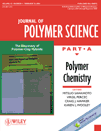Sulfonated naphthalene dianhydride based polyimide copolymers for proton-exchange-membrane fuel cells. I. Monomer and copolymer synthesis
Abstract
A novel sulfonated diamine, 3,3′-disulfonic acid-bis[4-(3-aminophenoxy)phenyl]sulfone (SA-DADPS), was prepared from m-aminophenol and disodium-3,3′-disulfonate-4,4′-dichlorodiphenylsulfone. The conditions necessary to synthesize and purify SA-DADPS in high yields were investigated in some detail. This disulfonated aromatic diamine, containing ether and sulfone linkages, was used to prepare N-methyl-2-pyrrolidinone-soluble, six-membered ring polyimide copolymers containing pendent sulfonic acid groups by a catalyzed one-step high-temperature polycondensation in m-cresol. These materials showed much improved hydrolytic stability with respect to phthalimides. High-molecular-weight film-forming statistical copolymers with controlled degrees of disulfonation were prepared through variations in the stoichiometric ratio of disulfonated diamine (SA-DADPS) in its soluble triethylamine salt form to several unsulfonated diamines. Three unsulfonated diamines, bis[4-(3-aminophenoxy)phenyl] sulfone, 4,4′-oxydianiline, and 1,3-phenylenediamine, were used to prepare the copolymers. The characterization of the copolymers by 1H NMR, Fourier transform infrared, ion-exchange capacity, and thermogravimetric analysis demonstrated that SA-DADPS was quantitatively incorporated into the copolymers. Solution-cast films of the sulfonated copolymers were prepared and afforded tough, ductile membranes with high glass-transition temperatures. Methods were developed to acidify the triethylammonium salt membranes into their disulfonic acid form, this being necessary for proton conduction in a fuel cell. The synthesis and characterization of these materials are described in this article. Future articles will describe the performance of these copolymers as proton-exchange membranes in hydrogen/air and direct methanol fuel cells. © 2004 Wiley Periodicals, Inc. J Polym Sci Part A: Polym Chem 42: 862–874, 2004




